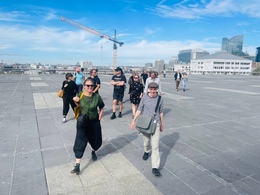Maximiliaan Royakkers
Maximiliaan Royakkers (1988, BE) is an artist and architect based in Brussels. His transdisciplinary practice blends artistic, educational and architectural approaches. After studying architecture at the KULeuven (2012) and obtaining a master’s from the Studio for Immediate Spaces at the Sandberg Instituut Amsterdam (2014), his work develops through reflections on social, political and ecological relationships that unfold in spaces. In his projects, he tries to establish relationships with places and situations through intensive fieldwork, by picking up a role, and by initiating spatial practices that weave together local perspectives with global dynamics. In this way, he tries to experiment with alternative forms of cohabitation.
In 2018, Royakkers and Ciel Grommen initiated Seasonal Neighbours, a loosely-fixed collective or artists, designers and social scientists, focusing on different forms of seasonality and cohabitation. Every member shares a fieldwork experience somewhere on Europe’s countryside. Through art and design interventions, critical conversations, thoughtful representations and written research, this experience is subsequently explored through a myriad of themes: from the evolution of the metabolism of horticulture, the changing rural landscape and European labour migration stories, to questions about the economy of scale in the agriculture sector, domesticity, public space, new forms of citizenship, etc.
In 2019, Grommen and Royakkers initiated an extensive fieldwork at C-mine site in Winterslag (Genk), where CIAP kunstverein is settled. The ongoing project, entitled Le Paysage Ménagé, questions the ability to create an architecture that does not occupy a site, but rather inhabits it. The aim of the project is not only to mark the physical presence of CIAP on the site, but to enter into a dialogue with the local landscape and form new alliances between its different actors (organisations, artists, inhabitants, animals and plants), areas (existing architecture, civic infrastructure, spoil tips, empty lots), and functions (residential, educational, cultural, commercial). Pragmatically questioning land property, through uses and relationships, this research and practice are embedded in Emptor’s framework, Caveat’s new chapter on property.
With Clémentine Vaultier and Grommen, Royakkers is part of Atlas of Ovens, an ongoing collaborative research project on infrastructures of heat. How and what do we fire, with whom do we share the resulting warmth? The artists research how these infrastructures can transform not only matter, but our relationships to communities and territories.
Royakkers is part of the Speap (école des arts politiques) program at the university SciencesPo in Paris, the program led by Frédérique Aït-Touati, who has taken over this role from Bruno Latour. Works have been exhibited at Bureau Europa, Jan Van Eyck Academie Maastricht, De Singel Antwerp, Z33 Hasselt, Le Grand Hornu Mons, Beaux Arts Paris…But works appear even more often in the “real” world, such as on the parking lot of an Aldi supermarket in Borgloon, at the foot of the terril in Winterslag.
Read about Max’s work on the metadated research tool of caveat.be







